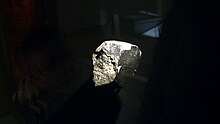Nakhla (meteorite)
Coordinates: 31 ° 9 ′ 0 ″ N , 30 ° 21 ′ 0 ″ E
Nakhla (German Nachla ) is a well-known Martian meteorite that hit near the village of El Nakhla El Bahariya in Abu Hummus, al-Buhaira ( Egypt ) in 1911 . It was the first meteorite reported in Egypt and the first to have traces suggesting the previous presence of liquid water on Mars . Its geological age is dated to around 1.3 billion years.
In the classification of Martian meteorites, Nakhla is the prototype for Nakhlite .
history

The meteorite struck on June 28, 1911 at around 9 a.m. Remains have been found near small ponds of Ezbet Abdalla Zeid, Ezbet Abdel Malek, Ezbet el Askar and Ezbet Saber Mahdi .
Eyewitnesses reported that it came from the north-west at an angle of about 30 degrees, leaving a column of white smoke. Several explosions were heard before it spread over an area 4.5 km in diameter. About 40 fragments , each weighing between 20 g and 1813 g, were found up to a meter deep. The original total mass was about 10 kg.
Two fragments found near Ezbet Abdel Malek were donated to the British Museum in London by the Egyptian government .
The Nakhla dog
According to the farmer Mohammed Ali Effendi Haki , a piece of the meteorite hit a dog when it hit the village of Denshal and evaporated it on the spot. Since no remains of the dog were found and the farmer was the only eyewitness, the story is rather dubious but has become a legend among astronomers.
Signs of water
Nakhla is the first meteorite in which traces were found that could only have formed in the presence of liquid water: carbonates and minerals formed by chemical reactions in water. The 13 C content in the carbonates suggests origin from Mars.
Also, after the stone was formed, it was exposed to water, which led to secondary deposits of minerals .
Signs of life
After receiving a piece of the meteorite from the British Museum, scientists at NASA Johnson Space Center examined the meteorite using a light microscope and a scanning electron microscope (SEM) in March 1999 . In this biomorphic traces discovered.
Carbon-containing pores and channels
In 2006, NASA was allowed by London's Natural History Museum to break up one of its intact fragments of the meteorite to examine fresh, uncontaminated samples. A wealth of complex carbonaceous materials containing dendrite-like pores and channels was found in it. These are similar to the effects of bacteria in stones that are known from the earth.
At the 37th Lunar and Planetary Science Conference in March 2006 in Houston, Texas, the postulate was debated that the carbon content within the pores of the stone consists of the remains of living matter. However, since carbon is the fourth most abundant element in the universe (after hydrogen , helium, and oxygen ), the majority of participants felt that the presence of shapes similar to those found in living organisms was not enough to prove that bacteria once lived on Mars.
amino acids
In 1999, various amino acids were isolated from fragments of the meteorite at the Johnson Space Center , including aspartic acid , glutamic acid , glycine , alanine and butyric acid . However, it is not certain whether these originate from the meteorite or from earthly contamination.
Cell-like microbubble
In 2014, research at the National Technical University of Athens discovered an oval cell- like microbubble and analyzed it in collaboration with the University of Manchester . The cell consists of nanocrystalline iron- containing saponite and amorphous materials . Many features of the microcell are similar to fossilized biological cells known from Earth. It was probably not a cell, however, but was created by a small inclusion of water that was heated by the asteroid impact on Mars.
See also
- Astrobiology
- Allan Hills 84001 (Martian meteorite)
- NWA 7034 (Martian meteorite)
- List of meteorites
literature
- Howard V. Hendrix: Red Rover, Red Rover . Ed .: Analogous to SFSF. July - August, 2012, p. 109-116 .
Web links
Individual evidence
- ↑ DP Glavin, JL Bada, KLF Brinton, GD McDonald: Amino acids in the Martian meteorite Nakhla . In: Proceedings of the National Academy of Sciences . tape 96 , no. 16 , August 3, 1999, p. 8835-8838 , doi : 10.1073 / pnas.96.16.8835 .
- ↑ a b c G. T. Prior: The Meteoric Stones of El Nakhla El Baharia (Egypt) 1 . In: Mineralogical Magazine . tape 16 , no. 76 , 1912, pp. 274–281 , doi : 10.1180 / minmag.1912.016.76.04 ( PDF [accessed on September 19, 2014]).
- ↑ a b c Ron Baalke: The Nakhla Meteorite. NASA Jet Propulsion Laboratory , 1996, accessed September 19, 2014 .
- ↑ a b Kathleen McBride, K. Righter: The 100th Anniversary of the Fall of Nakhla: The Subdivision of BM1913,25. NASA Johnson Space Flight Center, accessed September 19, 2014 .
- ^ The legend of the Nakhla dog. Retrieved September 19, 2014 .
- ^ A b Daniel P. Glavin, Jeffrey L. Bada, Karen LF Brinton, Gene D. McDonald: Amino acids in the Martian meteorite Nakhla. PNAS , April 2, 1999, accessed September 19, 2014 .
- ^ Paul Rincon: Space rock re-opens Mars debate. BBC News, February 8, 2006, accessed September 19, 2014 .
- ^ David Whitehouse: Life on Mars - new claims. BBC News, August 27, 1999, accessed September 19, 2014 .
- ^ Martian meteorite yields more evidence of the possibility of life on Mars. University of Manchester , September 15, 2014, accessed September 19, 2014 .
- ↑ Elias Chatzitheodoridis, Sarah Haigh, Ian Lyon: A Conspicuous Clay Ovoid in Nakhla: Evidence for Subsurface Hydrothermal Alteration on Mars with Implications for Astrobiology . In: Astrobiology . tape 14 , no. 8 , July 21, 2014, p. 651–693 , doi : 10.1089 / ast.2013.1069 .


